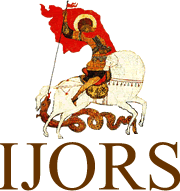
ISSN: 2158-7051
====================
INTERNATIONAL JOURNAL OF
RUSSIAN STUDIES
====================
ISSUE NO. 12 ( 2023/2 )
 |
ISSN: 2158-7051 ==================== INTERNATIONAL JOURNAL OF RUSSIAN STUDIES ==================== ISSUE NO. 12 ( 2023/2 ) |
NUCLEAR RUSSIA, THE ATOM IN RUSSIAN POLITICS AND CULTURE, By Ayse Dietrich*,
Published by: Bloomsbury Academic, Written by Paul R. Josephson, Year of Publishing: 2022.
Subject Area: Nuclear
Soviet Union 1917-1991, Book
Type: Russian History and Politics. Total Number of Pages: 140. ISBN: 9781350272552,
hardback, $ 13,01.
This
book is about the importance and the development of nuclear power during the
Soviet Union from the era of Joseph Stalin through the Soviet leaders Nikita Khrushchev,
Leonid Brezhnev and Mikhail Gorbachev, the challenges to the nuclear enterprise
caused by the economic and political collapse in Russia in the 1990s and its
recovery, post-Chernobyl and post-Boris Yeltsin, and during the presidency of
Vladimir Putin.
In
the first chapter, the author discusses the rise of nuclear science in Russia
under the Bolsheviks, from the Revolution in 1917 until the Second World War,
how the Bolsheviks attempted to build their own technological systems and even
bought western technology or used industrial espionage. During the Stalinists
era, however, the scientists had to follow an ideology of Stalinist science
policies, and science had to serve the immediate and practical needs of the Soviet
economy. In Ukraine the scientific enterprise grew despite the strict Stalinist
industrialization and collectivization campaigns.
In the second chapter, Josephson examines
the beginning of the Soviet atomic bomb project,
and how scientists convinced Stalin, the secret police chief of Cheka, Lavrenty Beria, and others to begin a crash program which gave
rise to a series of secret institutes working on bombs and other nuclear
applications and the creation of special settlements closed to the outside
world, called ZATO, and how espionage
played an important role in the success of the Soviet atomic bomb project.
In
the third chapter, the author also talks about how Soviet physicists had great
authority due to their contribution to the victory in the World War II and
their efforts to secure nuclear weapons during the Cold War, how they created a
program of peaceful applications, especially the Soviet achievement of the
Soviet peaceful atom, the work of Igor Tamm and Andrei Sakharov on controlled
thermonuclear synthesis and Soviet successes in peaceful
uses of atomic energy after
President Eisenhower’s speech “Atoms for Peace” to transform the atom from a life-threatening
weapon into a benefit for mankind, and an achievement
in the nuclear sphere, the establishment of détente with the United States.
In the fourth chapter, Josephson talks about the Brezhnev era and how nuclear power became both a symbol, and a crucial
component, of these economic and
technological achievements, the increased nuclear industry efforts in
the Brezhnev era across the European USSR to build scores of reactors, how the
Cold War nuclear industry accelerated from 1945 till the Chernobyl disaster in
1986; and the efforts to stop the growth in strategic arms (SALT I and SALT II)
negotiated by Brezhnev, Nixon, Ford and Carter.
In the fifth chapter, the author
discusses Mikhail Gorbachev’s intention to reform the Soviet society, economy
and political system by introducing perestroika and glasnost, his efforts to reform
the Communist Party and the state structure, the government effort to hide and
cover up the facts about Chernobyl which became a symbol of Soviet radioactive
failure, how the Chernobyl disaster fueled
anti-nuclear, environmental, and nationalist movements, how Chernobyl triggered
independence movements in several republics, and sparked environmental activism
in the USSR, and how Chernobyl accelerated the collapse of the USSR.
In
the sixth chapter, the author states that after the Chernobyl incident the
construction of nuclear power stations in Russia ended and the Yeltsin
administration revealed the true extent of radioactive pollution in all regions
in the USSR. Under Putin, the Chernobyl accident and ongoing waste problems
were acknowledged, but did not stop the bold plans for the nuclear renaissance.
Josephson stresses that Putin determined to build a strong state on natural
resources, and to make Russia a scientific superpower through achievements in
space and nuclear power, and in Russia “the atom remains for Russia a crucial tool
of domestic and foreign policy, and a central component of energy strategies,
and industry, it is a tool of the economy, a cudgel in foreign policy, and a
manifestation of a scientistic culture” in the 21st century.
This
book makes a valuable contribution to the study of history of the nuclear
science of the Soviet Union. The writer presents a detailed analysis of the nuclear studies from the era of Joseph Stalin until
Mikhail Gorbachev. Josephson’s work would be of
interest to academicians, researchers and students who are interested in the
development of nuclear
science during the Soviet Union.
*Ayse Dietrich - Professor, Part-time, at Middle East Technical University, Department of History and Eurasian Studies. Editor and the founder of the International Journal of Russian Studies (IJORS) e-mail: editor@ijors.net, dayse@metu.edu.tr, dietrichayse@yahoo.com
© 2010, IJORS - INTERNATIONAL JOURNAL OF RUSSIAN STUDIES